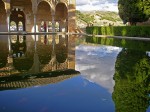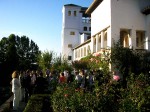The monumental site of the Alhambra and Generalife in Granada (Spain) offers some of the most beautiful of the Al Andalús landscapes. Declared a Cultural Landscape site and Heritage of Mankind by UNESCO, the Alhambra in Granada (Spain) is not just a group of palatial buildings but a collection of defensive and civil architecture that cleverly interacts with secluded gardens and orchards and with the water that flows playfully in every nook and cranny of the palace grounds.
“I am an orb of water that creatures see as clear and transparent / a great Ocean whose shores are carefully worked in marble / and whose waters, in the shape of pearls, run over meticulously carved ice. / I am flooded by water, but from time to time, / I shed the transparent veil that covers me”. These were the words used by the poet Ibn Zamrak (1333-1393) to describe the Daraxa garden. In his poems, he recorded every fountain, every doorway and every wall panel.
 Construction of the palace-city of La Alhambra was made possible by a plentiful supply of water, raised by a water-wheel from the river Darro and carried along the Main Canal.
Construction of the palace-city of La Alhambra was made possible by a plentiful supply of water, raised by a water-wheel from the river Darro and carried along the Main Canal.
Without the water that is everywhere evident in ponds, fountains and channels, even cascading down the banisters of staircases, the gardens of the Alhambra and the Generalife would never have existed. “When we contemplate the Alhambra, we get the feeling that the Arab’s ideal was to live in a garden”, said Spanish architect Fernando Chueca Goitia.
The most beautiful walled gardens are to be found in the Alhambra palaces, forming an inseparable part of the architecture and penetrating the interiors. The Abencerrajes and Dos Hermanas rooms are connected with the outdoors (Patio de los Leones) by an unbroken channel and a basin, creating a sensation of continuity and an effect of luminosity and movement, and emulating the rooms of the Koranic paradise “through which streams flow”.
A sheet of water
 In the Patio de Arrayanes (or Patio de Comares), the sheet of water reflects the facades and porticoes, duplicating the feeling of space, while the green myrtle border breathes freshness into the whole ensemble.
In the Patio de Arrayanes (or Patio de Comares), the sheet of water reflects the facades and porticoes, duplicating the feeling of space, while the green myrtle border breathes freshness into the whole ensemble.
The Patio de la Acequia in the Generalife summer palace, however, is a narrow, elongated space, full of vegetation arranged around a pond supplied by the Main Canal. Here the jets form a sparkling curtain of water, a delight for both eye and ear.
 The other gardens in the Generalife – the Upper Gardens, the Lower Gardens, the Sultan’s Cypress Courtyard, and the cypress and oleander avenues, with their symmetry and luxuriance – are Baroque and Romantic reinterpretations of the Al-Andalús garden, but they offer welcome shade and enjoyment to visitors. Here, alongside the centennial box plants grows a botanical curiosity, the Mirtus betica, a sort of myrtle introduced in the 16th century that is to be found in very few other locations.
The other gardens in the Generalife – the Upper Gardens, the Lower Gardens, the Sultan’s Cypress Courtyard, and the cypress and oleander avenues, with their symmetry and luxuriance – are Baroque and Romantic reinterpretations of the Al-Andalús garden, but they offer welcome shade and enjoyment to visitors. Here, alongside the centennial box plants grows a botanical curiosity, the Mirtus betica, a sort of myrtle introduced in the 16th century that is to be found in very few other locations.
Beyond these emblematic gardens are the orchards, in process of restoration and not open to visitors. Their terraces lead gently down to the valley, overlooking the city of Granada, a sight that works its magic especially in the evening hours.
Text and pictures: Inés Eléxpuru
This post is available in: English Español

